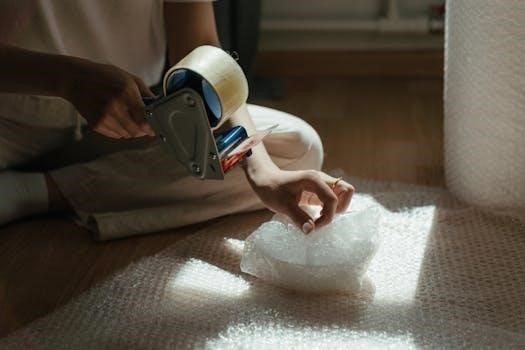
The 4-in-1 crib is a versatile piece of furniture designed to grow with your child. These cribs can convert from a standard crib to a toddler bed‚ daybed‚ and eventually‚ a full-size bed‚ offering long-term value.
Understanding the Versatility of 4-in-1 Cribs
4-in-1 cribs are designed with adaptability in mind‚ offering a significant advantage over traditional cribs. Their primary function is to serve as a safe and secure sleep space for infants. However‚ their versatility shines through their ability to transition into a toddler bed‚ a daybed‚ and finally‚ a full-size bed. This adaptability means that the crib can be a long-term investment that grows with your child’s needs‚ eliminating the need to purchase separate beds as they get older. The ability to convert these cribs provides both convenience and cost savings‚ making them a practical choice for parents looking for furniture that can adapt to their child’s changing stages; This also ensures a familiar sleep environment for your child.

Initial Steps Before Assembly
Before beginning assembly‚ it is crucial to check all parts and hardware against the provided list. Carefully read the instruction manual to understand the process and any safety guidelines.
Checking Parts and Hardware
Prior to initiating the assembly of your 4-in-1 crib‚ a meticulous inventory of all components is essential. Begin by cross-referencing the physical parts against the detailed parts list included in your instruction manual. Ensure that you have all the necessary side panels‚ headboard‚ footboard‚ mattress support‚ slats‚ and any conversion pieces that might be included for later stages. Next‚ scrutinize the hardware package‚ verifying that you possess the correct number and type of bolts‚ screws‚ washers‚ and any other fasteners required. It is important to pay close attention to the sizes of the screws and bolts‚ as using the wrong ones could compromise the crib’s structural integrity. This step is not only about ensuring you have everything but also about preventing delays during assembly. Having all parts accounted for will streamline the process significantly and contribute to a successful and safe setup of the crib.
Reading the Instruction Manual Carefully
Before commencing any physical assembly of your 4-in-1 crib‚ a thorough and careful reading of the instruction manual is absolutely crucial. This manual is your comprehensive guide‚ providing step-by-step directions‚ diagrams‚ and specific instructions relevant to your particular crib model. Begin by familiarizing yourself with all the terminology‚ parts identification‚ and safety warnings outlined in the document. Pay close attention to the order of assembly steps‚ as deviating from this sequence could lead to errors or instability. Note any specific torque requirements for bolts and screws‚ as over-tightening or under-tightening can be detrimental to the crib’s structure. The manual may also contain important information about converting the crib into its various modes‚ such as the toddler bed‚ daybed‚ and full-size bed. Ignoring these details may result in an improperly assembled crib and potential safety issues‚ so make sure every detail is studied before starting.

Crib Assembly Stages
The assembly process involves several key stages‚ starting with the crib frame‚ then securing the mattress support. Each stage requires careful attention to the instruction manual and proper use of hardware.
Assembling the Crib Frame
Begin by carefully unpacking all components and verifying against the parts list in your instruction manual. It is crucial to identify each piece before starting. Locate the side panels‚ headboard‚ and footboard. Using the appropriate bolts‚ washers‚ and Allen wrench provided‚ loosely attach the side panels to the headboard and footboard. Do not fully tighten the bolts at this stage. Ensure all parts align properly‚ paying close attention to the pre-drilled holes. It’s advisable to use wax or soap on the bolts to facilitate the assembly process. Double-check that the frame is square and stable before proceeding. This initial step is fundamental to the overall structural integrity of the crib. Remember to keep all small parts away from children during the assembly process to prevent a choking hazard.
Attaching the Mattress Support
Once the crib frame is assembled‚ carefully position the mattress support inside the frame. Most 4-in-1 cribs feature adjustable mattress support heights. Select the desired height‚ usually the highest setting for newborns‚ and flip up the attachment brackets at each corner of the mattress spring. Align the mattress support with the pre-drilled holes on the interior side panels. Use the specified bolts to secure the mattress support to the frame‚ ensuring it is firmly attached and level. It is important to not use more than one mattress. Double check for stability and proper alignment. Ensure that the mattress support is securely fastened to the frame‚ preventing any movement or risk of collapse.

Conversion to Other Modes
The 4-in-1 crib’s design allows for easy transitions. It can convert to a toddler bed‚ daybed‚ and full-size bed. Each conversion requires specific steps and additional parts may be needed.
Transitioning to a Toddler Bed
Transitioning your 4-in-1 crib to a toddler bed is a significant step‚ usually occurring when your child starts attempting to climb out of the crib. This conversion typically involves removing one of the side panels and often requires a toddler guardrail for safety‚ which may be sold separately. Consult your crib’s instruction manual for specific steps and hardware requirements. Ensure all connections are secure and that the toddler rail is properly attached to prevent any accidents. The height of the sides must be at least 200mm from the top of the mattress to the upper edge of the sides after conversion. This conversion provides a lower sleeping surface‚ allowing your child to get in and out of bed independently while still providing a secure environment. Always follow the manufacturer’s guidelines to ensure safety.
Converting to a Daybed
Converting your 4-in-1 crib into a daybed is another transition phase that provides a comfortable and versatile seating area for your child. This conversion typically involves removing the front rail of the crib while keeping the headboard and footboard intact. The process is similar to the toddler bed conversion‚ but without the toddler guardrail. Your crib’s instruction manual is essential for this step‚ as it will detail which parts to remove and if any additional hardware is required. Ensure all remaining connections are tight and secure. The daybed offers a cozy place for your child to relax during the day and can serve as an interim solution before moving to a full-size bed. Double-check all attachments for stability and safety before use.
Preparing for Full-Size Bed Conversion
The final stage in the life of your 4-in-1 crib is its transformation into a full-size bed‚ which typically requires the use of conversion rails‚ which are often sold separately. It is crucial to refer to your crib’s specific instruction manual to identify the correct rails for your model. This conversion will involve dismantling the daybed setup‚ attaching the full-size bed rails to the headboard and footboard‚ and fitting the bed frame. Ensure all the bolts are tightened correctly and that the structure is stable. It is important to review the weight limits for this configuration to ensure safe use. Once converted‚ the full-size bed provides a familiar and comforting sleep space for your growing child.

Safety Guidelines and Maintenance
Proper assembly is crucial for safety; always follow instructions carefully. Regularly check for loose hardware and ensure the mattress fits snugly. Clean with a dry cloth to maintain the crib.
Importance of Correct Assembly for Safety
Ensuring the 4-in-1 crib is assembled correctly is paramount for your child’s safety. Improper assembly can lead to instability‚ posing risks of collapse or parts detaching‚ which could cause serious injury. Always adhere to the manufacturer’s instructions‚ using the provided hardware and tools. Double-check each connection to confirm it is secure and stable‚ before placing your child into the crib. Pay close attention to the slat attachments and the mattress support. Confirm that every bolt is tightened appropriately and not overtightened. Regular inspections are crucial to identify any potential issues that may arise with use. If you are unsure of any step during assembly‚ seek assistance. Never attempt to modify the crib in any way that is not intended by the manufacturer‚ as this can compromise its structural integrity and safety. Following these steps will help ensure that your crib provides a safe and secure space for your child.
Maintenance and Care of the Crib
Regular maintenance is essential to keep your 4-in-1 crib in optimal condition and ensure your child’s safety. Dust the crib regularly with a soft‚ dry cloth to prevent buildup. Avoid using harsh chemicals or abrasive cleaners‚ as these may damage the finish. Periodically check all bolts and screws to ensure they are still tightened correctly and not loosened over time‚ as this could compromise the structural integrity of the crib. Inspect the slats and mattress support for any signs of damage or wear. If you notice any issues‚ contact the manufacturer for replacement parts. Do not use a mattress that is more than one inch thick. Always use the mattress support in the lowest position as soon as your baby can sit. Avoid placing heavy objects on or near the crib. Store the crib parts in a dry location. By following these maintenance tips‚ you can extend the life of your crib and ensure it remains a safe sleep environment for your child.